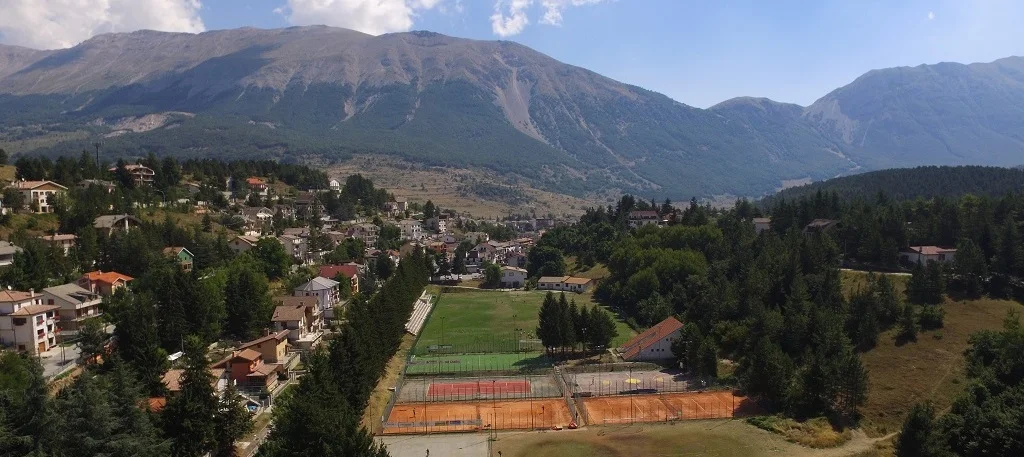La Location

Campo Di Giove
Campo di Giove è un piccolo comune situato nella provincia dell'Aquila, in Abruzzo, all'interno del Parco Nazionale della Majella. Questo pittoresco paese di montagna, situato a un'altitudine di circa 1.064 metri, è circondato da una natura rigogliosa e incontaminata, rendendolo una meta ideale per gli amanti della natura e delle attività all'aperto. Il centro storico, caratterizzato da strette vie lastricate e antiche case in pietra, offre un'atmosfera suggestiva e autentica.
La cucina locale è ricca di piatti tradizionali abruzzesi, con un'abbondanza di ingredienti genuini e prodotti locali, tra cui arrosticini, formaggi, salumi, pasta fatta in casa e dolci tipici. Campo di Giove ospita diverse feste e sagre durante l'anno, tra cui celebrazioni religiose, eventi culturali e manifestazioni enogastronomiche, che attirano visitatori e turisti.
Campo di Giove rappresenta una destinazione ideale per chi cerca una vacanza all'insegna della tranquillità, della natura e delle tradizioni autentiche abruzzesi.
Eventi e attrazioni
Essendo situato nel Parco Nazionale della Majella, Campo di
Giove offre numerosi sentieri per escursioni, trekking e passeggiate
nella natura. Le montagne circostanti, tra cui Monte Amaro, Tavola
Rotonda, Monte Coccia e Monte Porrara, offrono panorami mozzafiato e
sono mete popolari per gli escursionisti. Campo di Giove è anche una
destinazione popolare per gli sport invernali, grazie alla presenza di
impianti di risalita e piste per lo sci. Durante l'estate, oltre alle
escursioni, è possibile praticare mountain bike, arrampicata,
equitazione e altre attività all'aperto.
Per chi ama viaggiare “nel tempo”, sono consigliate le corse dei treni storici e turistici, curate dalla Fondazione FS che propone itinerari a bordo di carrozze d’epoca, sulla linea Sulmona-Isernia (inaugurata nel 1897) definita come la “Transiberiana d’Italia” che d’inverno presenta scenari di monti innevati e vallate imbiancate in pieno stile appenninico.
A ridosso della festività dell’Immacolata in paese vengono allestiti i “Mercatini di Natale” con una trentina di casine che propongono i migliori prodotti tipici della zona come arrosticini di carne, zuppe, formaggi, miele e dolci.
Durante l’estate Campo di Giove si caratterizza per un programma ricco di serate musicali, spettacoli teatrali e intrattenimento.
Gli amanti della montagna hanno la possibilità di poter fare escursioni in quota o più semplici passeggiate nei boschi e nelle pinete accompagnati da personale qualificato anche per l’osservazione diretta di animali come cervi, caprioli, camosci, lepri e lupi.
Il circondario
L’Hotel Abruzzo è inoltre convenzionato con un servizio navetta, per far scoprire ai propri ospiti le bellezze di paesi vicini ricchi di storia e tradizione abruzzese:
- Pescocostanzo. Fa parte dei “Borghi più belli d’Italia”, famoso per l’architettura urbanistica, l’arte orafa ancora viva e presente nelle caratteristiche botteghe di oreficeria, il tombolo e la Basilica di Santa Maria del Colle.
- Rivisondoli. Noto tra l’altro per il Presepe Vivente, il più antico e conosciuto nel suo genere che si tiene ogni anno il 5 gennaio. Con gli impianti di risalita del Monte Pratello fa parte del comprensorio sciistico di Roccaraso, il più esteso di tutto l’Appennino.
- Roccaraso. Nota località sciistica di caratura internazionale, famosa per gli impianti da sci considerati alla stregua delle più rinomate località alpine.
- Scanno. Famoso per il Lago che porta il nome del paese, uno dei borghi abruzzesi ritenuto tra i più belli della regione. Fa parte dei “Borghi più belli d’Italia”.
- Barrea. Rinomato centro turistico grazie soprattutto al lago omonimo e al Parco Nazionale d’Abruzzo, Lazio e Molise di cui fa parte.
- Pacentro. Tra i “Borghi più belli d’Italia”, con un centro storico e il castello “Caldora” di assoluto valore.
- Pettorano sul Gizio. È tra i “Borghi più belli d’Italia” con il centro storico e il castello “Cantelmo”.
- Sulmona. La patria di Ovidio, dei confetti e dell’artigianato locale. Centro di riferimento dell’interna Valle Peligna.
- Caramanico Terme. Rinomata località termale, fa parte dei “Borghi più belli d’Italia”.
